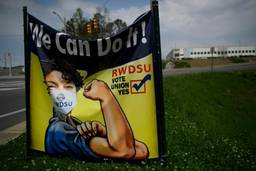
Despite new social media, the BBC’s Paul Mason see plenty of continuity in workers’ struggles since 19th century
CHICAGO — There are extensive parallels between revolutions and workers’ struggles of the past 150 years, and recent and ongoing uprisings from Egypt to Wisconsin. At the same time, contemporary movements are driven by social media and technology unimaginable even a few decades ago.
Ironically, media technology has played a central role in both the modern capitalist culture of individualism and disconnectedness that has stifled popular mobilization. But nonetheless, social movements have recently blossomed and spread like wildfire.
These were among the conclusions of BBC economics editor and blogger Paul Mason, who spoke at the Haymarket Brewery in Chicago Wednesday about his new book Live Working or Die Fighting: How the Working Class Went Global. “Instead of collective rights, people have been told to focus on their individual rights,” he said of the modern workplace and culture. “You rely more on technology than face to face.” (My recent Q & A with Mason for this site is here.)
But this reliance on technology feeds into what Mason sees as a key similarity between labor and social movements of the present and days past, when “the forms of struggle were beginning to mirror the forms of modern life.”
Mason pointed to a chain of uprisings worldwide in the past two years, including the post-election Iranian protests of 2009; the May 2010 Turkish protests over the attack on the Gaza-bound flotilla; the current revolts in the Middle East; the ongoing public union stand-off in Wisconsin; and the 2010 protests by French youth “taking a radical turn” in mass protests over raising the retirement age!
He sees distinct similarities between these and what he calls the “asymmetrical” nature of historical movements, including the Haymarket affair in Chicago and the Russian Revolution.
A review in The Independent says:
Mason proceeds by juxtaposition. The cruel intensity of today’s Shenzhen in China precedes an account of the struggle for rights in the Manchester cotton mills of Georgian England. The plight of Indian textile workers is set against the tale of the Lyon silk weavers and their struggle for control of their livelihoods in the early 1830s.
The rise and fall of the first major American union movement, the Knights of Labour, and the great wave of unskilled union organisation before the First World War are recounted with some panache, and paralleled by the plight of Iraqi trade unionists and the migratory flotsam that clean Canary Wharf.
Mason also sees newly fertile ground for social change rooted in what he describes as an increasing overlap between previously disparate social groups: students, the unemployed, migrant laborers and workers of all educational and economic classes — including lawyers, doctors and other professionals — who now find themselves without jobs or opportunities.
“The economic crisis is not a blip – it’s like flipping a switch from ‘life will be better’ to ‘it’s going to be worse.’ ” Mason especially sees changes across the globe in the role of middle- or upper-class students who he said in his own day were content to be activist dilettantes….but no more.
“They are the cannon fodder for a huge multi-million dollar industry called education…It’s become purely commercial. They’re absolutely crucial to the finance sector, with student loans…This group is tested to within an inch of their lives every year. They promise your life will be better, but it’s not…Every starving student, lawyer, doctor cursing at the regime is a future revolution.”
While not discounting the role of “older” people like his 51-year-old self, Mason trumpeted the power of young workers and would-be workers, noting young “demographic bulges” and soaring youth unemployment rates in southern Europe and North Africa.
He added that the uprisings in the Middle East have shattered the idea of “the passive Arab world,” and the tragic earthquake in Japan may even break up the “social cohesion” built around a culture of obedience by Japanese workers.
Mason lauded the ability of the “swarm to overcome the hive” – the power of spontaneous action unmoored from strict ideology to overcome authoritarian or established structures. For this reason Mason downplayed the significance of the sit-down strikes in Flint, Mich., in the 1930s, saying, “It was a top-down thing…the left dominated by auto workers.”
“I think you have to dig deeper, deeper into your history to understand what’s happened rather than just looking at Flint, as great as that was.”
An audience steeped in Chicago and other labor and social movements of recent decades applauded Mason’s overall conclusions but challenged some of his points and his sense of optimism. Some questioned whether social media’s role in Egypt and elsewhere was overblown, and pointed out the danger of over-reliance on social media when such outlets can be shut down by repressive governments.
Veteran immigrants rights organizer Emma Lozano lamented that despite the massive marches of 2006 and 2007 that started in Chicago, undocumented immigrants and low-wage African American workers are greatly under-represented in the current U.S. labor and social justice movements.
Activist Nate Goldbaum pointed out that the U.S. immigrants rights marches of last decade – the largest mobilizations in recent history – were organized largely through “old-fashioned” Spanish-language radio and word of mouth, rather than social media.
“One of the things I like about [Live Working or Die Fighting],” Goldbaum said, “Is it takes note of things that are new, but also says we have to look back and not discard things because they’re ‘old.’”

I hope you found this article important. Before you leave, I want to ask you to consider supporting our work with a donation. In These Times needs readers like you to help sustain our mission. We don’t depend on—or want—corporate advertising or deep-pocketed billionaires to fund our journalism. We’re supported by you, the reader, so we can focus on covering the issues that matter most to the progressive movement without fear or compromise.
Our work isn’t hidden behind a paywall because of people like you who support our journalism. We want to keep it that way. If you value the work we do and the movements we cover, please consider donating to In These Times.
Kari Lydersen is a Chicago-based journalist, author and assistant professor at Northwestern University, where she leads the investigative specialization at the Medill School of Journalism, Media, Integrated Marketing Communications. Her books include Mayor 1%: Rahm Emanuel and the Rise of Chicago’s 99%.







